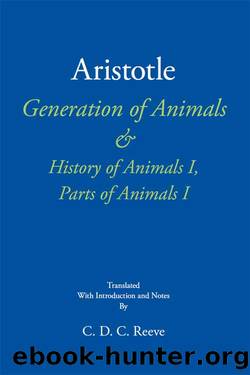Generation of Animals & History of Animals I, Parts of Animals I by Aristotle

Author:Aristotle [Aristotle]
Language: eng
Format: epub
ISBN: 9781624668272
Publisher: Hackett
Published: 2019-10-03T00:00:00+00:00
IV 4
Now Democritus |769b30| said that monsters come to be because two semens fall [into the uterus], one setting [the menses] in movement earlier, the other later, and this latter, once it issues forth, arrives in the uterus, so that the parts [of the embryo] grow together and become confused.777 But in the birds, he says, since mating always takes place quickly, both the eggs and their color |769b35| become confused.778 But if several offspring come to be from one semen and one act of sexual intercourse, which is just what appears to be the case, |770a1| it is better not to go the long way around, passing the short one by.779 For especially in such cases it is necessary for this to occur when the seeds are not disaggregated but instead arrive together [in the uterus]. If, then, we must attribute the cause to the semen from the male, that |770a5| is the way we would have to state it. But, in general, we must rather think that the cause resides in the matter [contributed by the female] and in the embryos being composed.
That is why too monsters of these sorts come to be altogether rarely in uniparous animals, but more frequently in the multiparous ones, and most of all in birds, and among birds most of all in chickens. For this bird |770a10| is multiparous not only in laying often, like the pigeon genus, but also because it has many embryos at the same time and mates all year round. That is also why it lays many twin-eggs. For the embryos grow together because they are close to each other, as many fruits sometimes do. |770a15| Of these twin-eggs, when the yolks are divided by the membrane, two separate chicks come to be having nothing extraordinary about them, but when the yolks are continuous, with nothing keeping them asunder, from these, chicks that are monstrous come to be, having one body and head but four legs and four wings. This is because the |770a20| upper parts come to be earlier from the white, the nourishment for them being dispensed from the yolk, whereas the lower part develops later and its nourishment is one and indivisible.780
Also already observed is a serpent that is two-headed due to the same cause. For this genus too is multiparous and lays many eggs. Monstrosities, however, are more rare |770a25| in their case due to the shape of the uterus. For because of its length the large number of eggs are set in a row.781 And where bees and wasps are concerned nothing of this sort occurs, because their offspring are in separate cells. But where {147} chickens are concerned the contrary is the case, which makes it clear that |770a30| we must consider the cause of these things to reside in the matter. For among the other animals too monstrosities occur more often in those that are multiparous. That is why in the human they are less common. For it is for the
Download
This site does not store any files on its server. We only index and link to content provided by other sites. Please contact the content providers to delete copyright contents if any and email us, we'll remove relevant links or contents immediately.
The European Opportunity by Felipe Fernández-Armesto(562)
The European History Highway: A Guide to Internet Resources by Dennis A. Trinkle Scott A. Merriman(514)
The Seven Wonders of the Ancient World by Michael Denis Higgins(505)
European Security in a Global Context by Thierry Tardy(494)
European Security without the Soviet Union by Stuart Croft Phil Williams(489)
The Routledge companion to Christian ethics by D. Stephen Long Rebekah L. Miles(485)
Hyperculture by Byung-Chul Han(457)
Morgan Kaufmann Digital Watermarking and Steganography by Ingemar Cox Matthew Miller Jeffrey Bloom Jessica Fridrich Ton(426)
Get Real with Storytime by Julie Dietzel-Glair & Marianne Crandall Follis(423)
Hudud Al-'Alam 'The Regions of the World' - a Persian Geography 372 A.H. (982 AD) by V. V. Minorsky & C. E. Bosworth(421)
Gorbachev And His Generals by William C. Green(410)
Tibetan Studies in Comparative Perspective by Chih-yu Shih Yu-Wen Chen(406)
Governance, Growth and Global Leadership by Espen Moe(402)
CliffsNotes on Fitzgerald's The Great Gatsby by Kate Maurer(382)
How Languages Are Learned 5th Edition by Patsy M Lightbown;Nina Spada; & Nina Spada(378)
The Oxford History of the World by Fernández-Armesto Felipe;(374)
The Egyptian Economy, 1952-2000 by Khalid Ikram(370)
Oral Poetry and Narratives from Central Arabia: The Poetry of Ad-Dindan : A Bedouin Bard in Southern Najd (Studies in Arabic Literature, Vol 17) (English and Arabic Edition) by P. M. Kupershoek P. Marcel Kurpershoek(357)
The Oxford Handbook of the Incas by Sonia Alconini(351)
